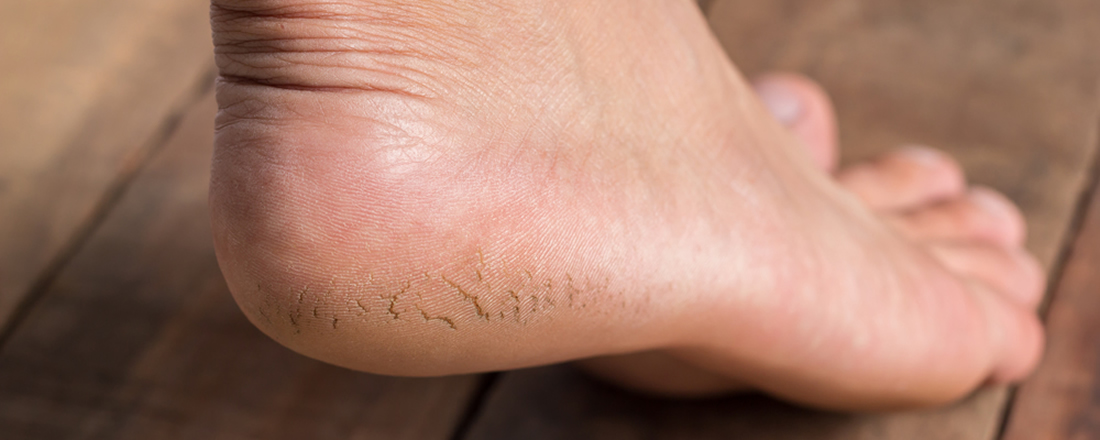
Skin Conditions
Athlete’s foot
Athlete’s foot is a common fungal infection that affects the skin. Often in areas that are enclosed and can become hot and sweaty. It is common in the feet and can affect all the skin on the feet. Symptoms can range from rashes to dry flaky and cracked skin which can be itchy or not. It can start between the toes and spread to the rest of the skin on the feet. The area between the toes can split and result in an infection if not treated. It can be quite mild or severe, so having it properly diagnosed is important. A podiatrist will be able to identify it and advise on the best treatment for you. You can usually treat it with antifungal creams, gels, and sprays, but it can keep coming back.
Callus – dry skin
Hard dry skin can form on the feet because of a genetic condition, pressure, weight, illness or shear. It can be very uncomfortable. A podiatrist would remove this and then give advice about how to prevent it and improve the condition of the feet.
Corns
Corns are little plugs of hard skin which form because of pressure or shear. They can be extremely painful and need removing by a professional. A podiatrist would remove the corn and then give advice on how to prevent it. This could be footwear, footcare or devices that help reduce pressure.
Verrucae
A useful advice leaflet is available from our clinic which you can request from us at enquiries@feet-first.org.
A verruca is a wart on the foot caused by the Human Papilloma Virus (HPV). They commonly occur on the soles of the feet and toes. Verruca can be contagious and transmitted through direct person-to-person contact. They tend to be common in children, teenagers, young adults and people who use communal changing rooms but anyone can get them. They often disappear by themselves but in some cases can be persistent and hang around for years. There are various treatments for verruca but they may not work. The podiatrist would discuss the options with you. We may recommend no treatment at all, over-the-counter treatments or more involved options such as needling or SWIFT.
SWIFT
THIS CLINIC DOES NOT OFFER SPECIFIC TREATMENTS FOR VERRUCAE INCLUDING SWIFT OR NEEDLING. WE DO OFFER COMPRHENSIVE ADVICE AND DEBRIDEMENT TO REDUCE PRESSURE AND PAIN.
A useful advice leaflet is available from our clinic which you can request from us at enquiries@feet-first.org.
SWIFT is a new technology, developed in the UK, which has been licenced for the general treatment of skin lesions such as warts and verrucae. Swift uses microwave energy which is delivered through a special probe applied to the skin to treat the affected tissue. The microwave energy generates heat focused under the probe to target the wart/verruca.
Sweaty feet – hyperhidrosis
Hyperhidrosis is a common condition in which a person sweats excessively. The sweating may affect the whole of your body, or it may only affect certain areas. Commonly affected areas include armpits, palms of your hands, soles of your feet, face, chest or groin. If your feet are affected, it can result in a condition known as pitted keratolysis which is a bacterial infection. Symptoms would be smelly feet, hard skin with little areas of pitting. This condition may require a topical antibiotic to treat it. The podiatrist would be able to diagnose this and advise on the best treatments available.
Chilblains
Chilblains (sometimes called pernio) are small, itchy, painful, red, or purple swellings on the skin. Chilblains are caused by an abnormal skin reaction to cold. They tend to occur on ‘extremities’ that easily become cold – that is, your toes, fingers, nose, and earlobes. However, other areas of skin sometimes develop chilblains when they become cold. An infection may occur should the skin break down. Podiatrists will offer treatment options and prevention advice.
Lumps and Bumps
Other dermatological conditions that affect the feet. There are many types of ‘lumps and bumps’ that can occur on the feet and legs. If you are concerned about an unusual lesion, your podiatrist would be able to assess it and may offer a possible diagnosis or provide advice.


